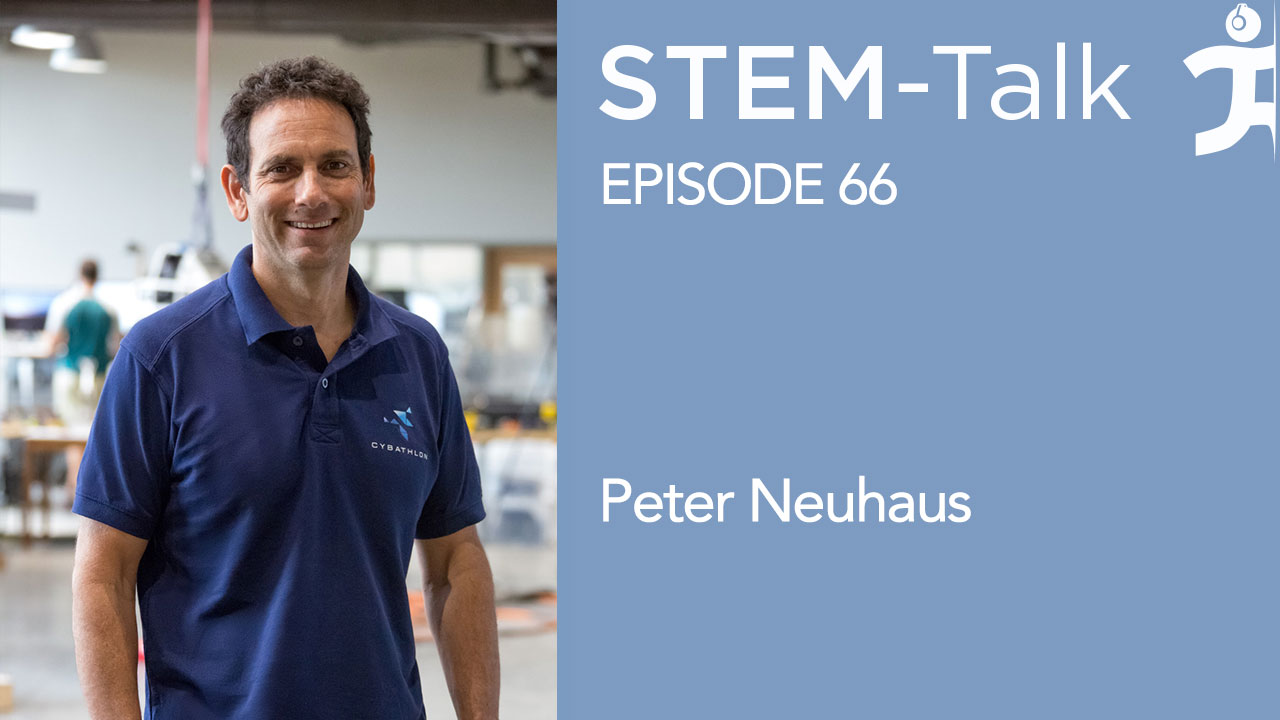STEM-Talk
Episode 66: Peter Neuhaus talks about exoskeletons, robotics, and the development of exercise technologies for space and Earth
// Jun 19, 2018

In today’s episode, Ken and Dawn interview their colleague Dr. Peter Neuhaus, a senior research scientist here at IHMC. Peter is an engineer well-known for his work on wearable robotic devices. In particular, Peter has focused on lower extremity exoskeleton devices and their applications for mobility assistance for paraplegics and other people with disabilities or partial paralysis.
In 2016, Peter lead an IHMC team that won a silver medal in the international Cybathlon, a competition conducted in Zurich in which people with disabilities used advanced assistive devices, including robotic technologies, to compete against each other.
In today’s interview, Peter talks about IHMC’s humanoid robotic efforts as well as his work with NASA designing an exercise machine for a human mission to Mars or other missions beyond low earth orbit.
Peter also describes the work he is doing with IHMC High-Performance Director Joe Gomes, the former Oakland Raiders strength and conditioning coach. Peter and Joe as well as others at IHMC are designing exercise technologies to extend the resilience of high-performing humans, such as astronauts and elite warfighters. Many of these technologies will eventually be able to be utilized by the general public.
Links:
Peter Neuhaus IHMC page:
https://www.ihmc.us/groups/pneuhaus/
DARPA Robotics Challenge videos:
Cybathlon videos:
http://robots.ihmc.us/cybathlon/
IEEE Robotics and Automation Magazine article about Cybathlon:
https://arxiv.org/pdf/1702.08656.pdf
IHMC newsletter article about Cybathlon:
https://www.ihmc.us/wp-content/uploads/2015/08/IHMCNewslettervol10iss3.pdf
IHMC newsletter article about DARPA Robotics Challenge:
https://www.ihmc.us/wp-content/uploads/2017/07/IHMCnewslettervol13iss1.pdf
Show notes:
3:03: Dawn asks Peter about growing up in New York City.
3:33: Ken mentions that after high-school, Peter enrolled at MIT. Ken asks Peter what led him there.
4:04: Ken asks why Peter decided to major in mechanical engineering.
4:35: Dawn asks Peter what led him to travel across the country to attend the University of California, Berkeley for graduate school after he graduated from MIT.
5:10: Dawn asks what it was like for Peter to teach science to 5th– and 6th-graders as well as high-schoolers in Brooklyn after he received his master’s degree from Berkeley.
6:23: Peter talks about how after two years of teaching, he decided his window of opportunity to get a doctorate was shrinking and that it was essentially “now or never,” which led him back to Berkeley.
7:02: Dawn mentions that once Peter finished his doctorate, he went to work for a startup as a mechanical engineer. She asks what sort of work he did there.
7:47: Dawn talks about how a year and a half after getting his doctorate Peter met his future wife, who eventually led him to Pensacola, and in a roundabout way, to IHMC. She asks if he could share how that all came about.
9:22: Ken comments on how since joining IHMC in 2003, Peter has focused on wearable robotics systems and legged robots. Ken further mentions that Peter was one of the lead IHMC researchers participating in the DARPA Learning Locomotion project, where he helped develop quadrupedal locomotion algorithms for the Little Dog robot. Ken asks if Peter could talk about his work on this project?
11:08: Dawn, continuing with the discussion about DARPA projects, mentions that Peter played an important role in both the development of technology and in the management of IHMC’s humanoid robotics effort for the DARPA Robotics Challenge that was held between 2013 and 2015. IHMC placed second and brought home $1 million in prize money. Dawn asks what that experience was like.
12:10: Ken mentions there were three competitions that were part of the robotics challenge, and asks Peter to talk about IHMC’s performance in each of the competitions.
12:57: Dawn mentions that for more than a decade, Peter has been working on exoskeletons, wearable robotic devices that assist people with paralysis and other disabilities. She asks Peter how he got interested in this, and if he could give an overview of what is involved in the development of exoskeletons.
14:39: Ken comments on how wearables are a challenging application for robotics. He asks if Peter could elaborate on some of the specific technical challenges that go along with it.
15:27: Dawn changes the topic to the Cybathlon, a competition, held in Zurich, Switzerland for people with disabilities who are supported by modern assistive technology. IHMC won another silver medal in that competition and Dawn asks about the IHMC team’s preparation for the Cybathlon.
18:18: Ken mentions that a key factor that set IHMC’s exoskeleton apart from the rest at the Cybathlon was the incorporation of powered ankles, which improved mobility. Ken asks Peter to talk about the importance of this feature that the team added to the exoskeleton.
20:05: Dawn asks whether the balancing algorithms that are used in humanoid robots could also be used for ekoskeletons.
22:25: Dawn reads something that Peter once said: “Humans are great at perception. We can look around an area and see where we should go, and what we should step on. But communicating that information to a computer is pretty challenging.” Dawn asks Peter what those challenges are, and if he could speculate about the features that might be incorporated into a state-of-the-art exoskeleton 10 years from now.
24:41: Dawn asks about Peter’s involvement in the X1 exoskeleton that was developed in collaboration with NASA Johnson Space Center.
25:32: Continuing the discussion about NASA, Ken mentions that Peter and his team are also working with NASA on an exercise machine for long duration deep-space missions, such as a Mars mission. Ken talks about how astronauts are so susceptible to bone density and muscle loss while in space that exercise is very important. He asks Peter about the challenges of building exercise devices specifically designed for microgravity.
27:22: Dawn quotes the director of exercise physiology of the Johnson Space Center, Dan Hagen, who said, “Exercise is the number one health priority for astronauts when they are in space. No other activity, except eating and sleeping, is given that much priority. Two and a half hours each day are devoted to fitness.” Dawn asks if a computerized exercise machine could reduce the amount of time someone needs to train, which would free them up to be more productive.
28:33: Ken asks about Peter’s thoughts on how his work with NASA on exercise technology could have applications here on earth.
29:21: Dawn mentions that IHMC recently hired Joe Gomes as the institute’s high-performance director. She goes on to mention that Ken is in the process of building a team to search for ways to extend the resilience of high-performing humans operating in extreme environments and conditions. The team multi-disciplinary team is comprised of engineers and software developers, physicians, pathologists, social scientists, and human-performance specialists to improve training and maximize a person’s physical and cognitive performance. In light of that, Dawns asks Peter to give an overview of how he is teaming up Joe to develop an exercise machine.
30:18: Dawn comments on how health and fitness wearables and apps have, up to this point, merely tracked activity and reported it after the fact. She goes on to ask if it’s correct that the device Peter and his team are developing will enable both the trainee and trainer to receive immediate feedback and prompts during a workout.
31:14: Ken asks Peter whether the technology he is developing with Joe and the rest of the team will get away from a one-size-fits-all model and lead to a more personalized-training model.
32:26: Dawn asks Peter about rehabilitation, and if the exercise machine, or some version of it, will help track and quantify someone’s rehab from injury.
33:37: Dawn asks about the potential commercial uses for the exercise device.
34:21: Dawn asks if computer-controlled motorized resistance also makes exercise safer.
34:55: Ken asks Peter to discuss how the exercise device could potentially help the aging population given that muscle mass begins to decrease substantially after age 60 and leads to falls, frailty and insulin resistance, among much else.
36:49: Dawn asks Peter about the Mobility Unlimited Challenge, sponsored by the Toyota Mobility Foundation. She asks about IHMC’s role and why Toyota is interested in exoskeleton technology.
37:34: Dawn mentions that recently IHMC hosted the 13th annual Dynamic Walking Conference, where students, professors and engineers from around the world gathered in Pensacola for five days of presentations and demonstrations. She asked Peter to explain what the conference was about and what were some of the highlights from the meeting.
38:57: Ken mentions that 2020 is shaping up to be a big year for Peter and the entire IHMC Robotics group. In addition to the Toyota Mobility Challenge, the next Cybathlon is also scheduled for 2020. Ken asks if Peter could discuss his plans for that event.
39:45: Dawn brings up how Peter likes to participate in triathlons, and that he’s been quite active in the triathlon club in Pensacola. She says she understands that Peter recently had to give up running and asks about if that’s true.
41:01: Dawn closes by asking Peter if there is any chance that one day some of the technology Peter is developing could help him get back into running.






